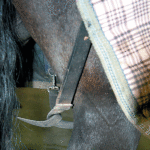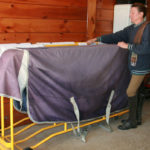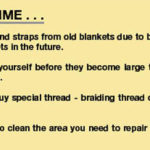A lot of money gets spent at this time of year on horse blankets. We want our horses to be healthy, clean and comfortable and, yes, look good. But many horses don’t need to be blanketed in the winter. And, if they do need blankets, we have to make the best choices for the horse or the blankets can cause real problems.

Nature has provided our horses with adequate protection from cold winter temperatures. A healthy horse with a full winter coat, who isn?t working so hard regularly that he sweats, doesn’t need a blanket. If a horse usually sweats when ridden, then he needs to be clipped, stabled and blanketed or he’ll get chilled and sick. An unclipped horse will do fine if he’s cooled out slowly and blanketed, but this takes extra time and work.
In addition to your horse’s blanketing needs, you also need to consider the routine where he lives. Do you keep your horses at home but are away during the day? Do you board your horse and have to conform to the stable?s practices? The blanket you use at night won?t be the best choice for daytime out in the pasture, but you may not be around to make the changes or your boarding barn may not be willing to switch stable and turnout rugs.
Temperatures. A common system at some boarding stables is to post the nighttime forecast on the message board. That way, boarders can dress their horses properly before they leave. Another way to reduce a lot of switching is to use a turnout sheet that just gets placed over the stable blanket rather than switching out a stable blanket for a turnout blanket and back again. The sheet can stay on at night if need be as long as it’s not damp.
One mistake many people make is to use a sheet when the temperature dips in the fall and spring. A sheet actually makes an unclipped horse colder rather than warmer, unlike when we ourselves put on a light jacket or sweater.
A horse’s coat will fluff up when he’s cold, trapping air in the hair, a form of insulation, like down. A sheet will prevent the coat from fluffing up. The actual job of a sheet is to keep the horse clean, not warm, either alone in mild weather or at a show or as a blanket liner.
Another mistake is turning out a horse in a waterproof rug without taking into account the forecast. The right blanket in the morning or on a cloudy day will make the horse sweat in direct sun and then chill in wetness later in the afternoon. Finding the right mix of waterproof/water-resistant/breathable for horses in the pasture can be tricky. A horse wearing no blanket can be safer and healthier than one stuck in the wrong blanket.
In the same vein, people will close up their barns at night to keep their horses warm, but horses need fresh air to prevent respiratory problems. A stable full of horses puts out a lot of body heat and moisture and they may be over-blanketed. Barn doors should be kept ajar except during blowing rain and snow. The horse’s own coat or a blanket should keep him warm enough as long as he’s dry and out of the wind.
There are, of course, exceptions to this minimalist approach. You know your own horse. If he has a thin coat or health problems or is older, he’ll need blankets more than a healthy younger horse with a thick coat. Watch that your horse isn?t losing weight or seems cold.
Blankets shouldn?t cause rubs if they fit correctly and if the horse’s coat is kept clean. When sweat builds up on the coat, the hair becomes brittle. Bacteria can also build up and make the coat vulnerable. If you can’t launder your stable blankets frequently, then you should use a sheet as a liner, since the sheet can be washed easily and frequently in a home machine.
Fit. Blanket rubs aren?t caused so much by the way the shoulder area fits as by whether the blanket is long enough (meaning to cover from shoulder to rump). If the blanket is too tight across the rump, then it pulls the shoulder tight when the horse stretches his neck down. Going by height can be misleading?blankets are better measured from the center of the horse’s chest straight back to the center of the dock: if the measurement is 72 inches, that’s the size. Each manufacturer has their own variation on sizing, so be sure to check.
Closed-front stable blankets keep in warmth best and are less likely to twist. However, they are less convenient than blankets with front closures. Look for blankets where the front closure overlaps, which keeps the horse warmer and prevents rubs.
There are multiple styles and features available for horses of different conformation types. Some blankets have adjustable neck openings and gussets over the legs. High-necked breeds will need a V-type opening to keep the withers and mane from being rubbed.
Tail flaps are a good idea to both keep in warmth and to prevent tail rubs, but they will get messy. We also prefer blankets with detachable leg straps.
When you get the blanket home, check the size by putting it on over a clean sheet. Then place hay in front of the horse so he stretches his neck down. Check to see that there is enough length so that the fabric doesn’t rub the shoulders or mane. The cut of the neck will affect rubs on the mane more than whether there is fleece on the withers, although the fleece helps.
You can use an elastic surcingle to help keep in place a layer that doesn’t have its own straps, such as an anti-sweat or cooler.
It’s also always a good idea to keep an extra set of elastic leg straps on hand in case one breaks or so you can wash a set that gets dirty.
Waterproof and Breathable?
There are no industry standards for these terms. That means manufacturers can put them on any blanket label, no matter the materials and construction, and make any claims they wish in advertising.
A fabric that is truly both waterproof and breathable has a special lining laminated to the inside. This membrane allows sweat to go out while keeping rain from getting in. The membrane has microscopic pores that are smaller than water drops but larger than water vapor. This membrane, found first and most notably in Gore-Tex, is expensive. Thus, a turnout blanket or sheet that is truly both waterproof and breathable is not going to be a bargain purchase, starting at $150 and easily going higher. The main Gore-Tex patent has expired, so other waterproof/breathable fabrics are now available ? one familiar name found in blankets is Sympatex. Check the tag for details on the faculties of the outer fabric itself and look for the laminated membrane. Laundering a fabric with this membrane shouldn?t affect its waterproof/breathable qualities, although some recommend that the waterproofing on the outer layer be enhanced by occasionally applying a product for that purpose that can be found at some tack shops and most outdoor stores.
Some fabrics, especially those made from natural fibers such as cotton or wool, are inherently breathable. Other fabrics are breathable because of their weave or construction. How can you tell if a blanket or sheet is breathable? Put the fabric up to your lips and try to suck in air. If you can, then the fabric will also allow moisture to evaporate. Some blankets claim ?breathability? simply because they add a loose-weave lining that allows airflow under the waterproof shell. You can achieve the same effect by using an anti-sweat sheet under a water-tight top layer. (Old-timers used to do the same thing in a way by sticking straw on the horse’s back under the blanket.)
Stable sheets and blankets need to be breathable. Don?t waste money there for one that is also waterproof. Turnout clothes where the horse is standing (or running at times) in full sun also need to be breathable. If a blanket has that expensive laminated membrane, the breath-through test with your lips won?t work. If it’s lined with another fabric, you won?t be able to see if the membrane is there. You?ll have to take the manfuactrurer?s claim on faith.
Waterproof fabrics used in moderately priced blankets are usually tightly woven synthetics that aren?t breathable. A blanket that is truly waterproof also needs to have no seam along the back and have tightly stitched construction elsewhere. You don’t want to have your initials or stable name embroidered onto a blanket that you’ll use for turnout because the stitching will be an entry point for rain. (Put the embroidery on a strap, if you must.) The people who manufacture waterproof/breathable fabrics usually insist that products made from them have durable construction and sealed seams, another reason such blankets are likely to be pricey.
A moderately priced blanket suitable for turnout that is breathable is usually, at best, just water-resistant, not waterproof. It should serve your horse fine except in pouring rain, keeping mud out when he rolls and allowing light rain to slide off before it can seep inside. If it gets really soaked, it will need to be removed from the horse and hung to dry on its own.
Blanket Terms and care.
Denier: Density of nylon fiber. The higher it is, the more durable (i.e. not a satisfactory chew toy) and water-resistant the blanket will be but also possibly less breathable. 1200 is a high density.
Ripstop: A raised square weave that keeps small rips from becoming large rips.
Fill weight: The amount of poly fill (insulation). Medium weight, up to around 225 grams. Heavy weight, 250 grams and up.
The care of a blanket will be determined by its materials and construction. A typical home washing machine can handle sheets and maybe coolers, but you’ll need a front-load washer (no agitator) to wash stable blankets yourself. Regular detergents can get the blankets clean, but you’ll a specialized blanket product to deodorize them. Check to see if the material or waterproofing treatment will require a specific product, water temperature and method of drying.
One of the most important components to blanket care is to get them cleaned and stored in the spring. Send them out right away for cleaning and repairs if necessary. If you have a front-loading washer, clean them yourself and then take the blanket to your cobbler for repairs?any cobbler who repairs luggage can usually fix up blankets as well and will insist that the blanket is clean.
Bottom Line. Healthy hard-working horses need blankets in the winter, especially if they are clipped. Otherwise in most situations, nature has provided them with protection from cold as long as they have adequate protection from wind and rain. Assess your needs based on your weather and the routine in your barn. Take care with fit and keep the layer that’s next to the horse’s coat as clean as possible to prevent rubs.
Article by Margaret Freeman, Associate Editor.
Blanketing Common Sense
Make this your mantra: Put blankets on from front to back. Take blankets off from back to front. That way you’re unlikely to forget a strap or hook that could make the horse kick out with the blanket halfway off or leave a strap or buckle loose that could then allow the blanket to twist under the horse.
Surcingles shouldn?t droop. A leg could get caught. The leg straps on a top layer should hold bottom layers in place, so remove any detachable straps on bottom layers.
Control the horse. Never change or adjust blankets in the pasture without a halter and lead rope on the horse.
Riding. Remove the tail strap on any cooler or quarter sheet that you toss behind the saddle while walking.
Watch out for static snap. The propensity for this varies from horse to horse, blanket to blanket, with longer coats and synthetic fabrics more likely to cause problems. If you use a static-prevention product, do so with the blanket flat on the ground. Don?t lift a layer and spray, especially while on the horse, because this can set off a static charge.







